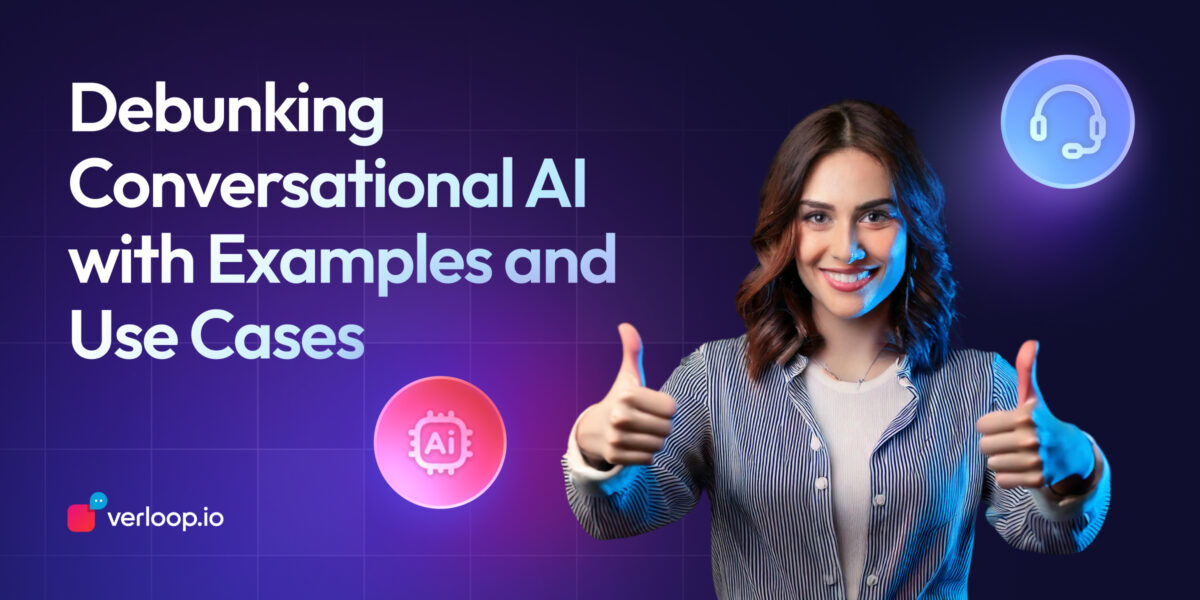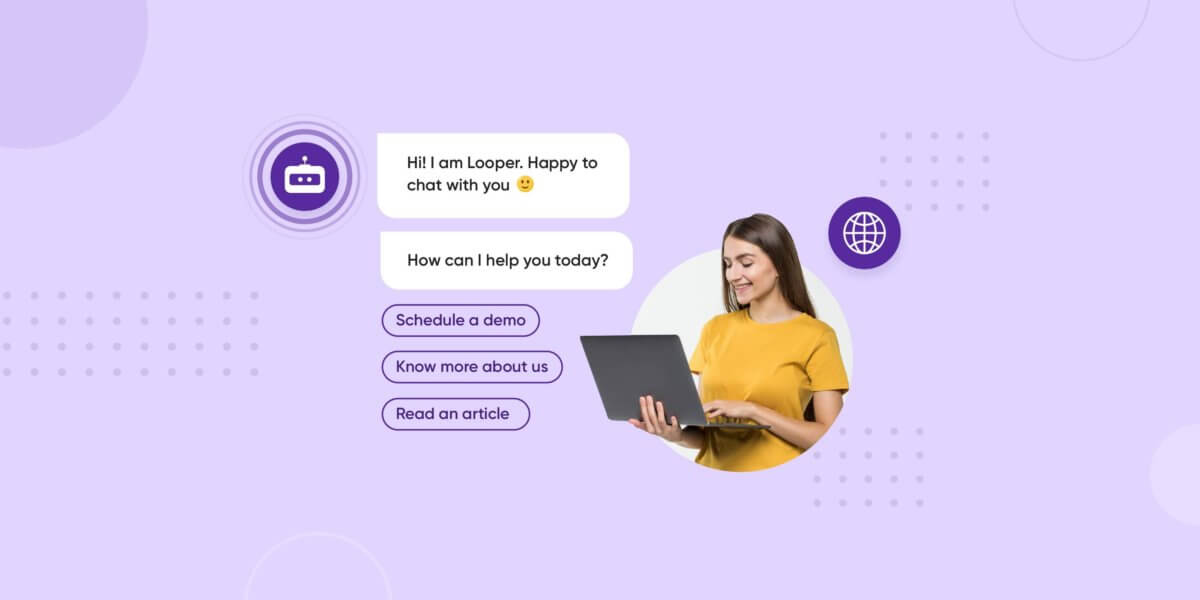Debunking Conversational AI with Examples and Use Cases
- May 14th, 2025 / 18 Mins read
-
Harshitha Raj

Debunking Conversational AI with Examples and Use Cases
- May 14th, 2025 / 18 Mins read
-
Harshitha Raj
Your customer lands on your website at midnight, frustrated because their payment didn’t go through. Instead of waiting for office hours, they type a message. Instantly, a smart assistant responds, verifies their details, and resolves the issue — no queues, no stress. That’s Conversational AI, a tool that doesn’t just answer questions but transforms customer support. With the potential to cut customer service costs by up to 30% and reduce overall business costs by up to 40%, it’s helping banks, e-commerce platforms, and service providers deliver 24/7 support without breaking the bank
Conversational AI makes the more natural, human-like communication with machines possible, which is quickly changing the way we interact with technology. Natural language processing (NLP) and machine learning enable computers to comprehend context and intent, enabling them to react to user enquiries with intelligence. Based on estimates, the conversational Al market is expected to develop at a compound annual growth rate (CAGR) of 24.9% from USD 13.2 billion in 2024 to USD 49.9 billion by 2030. In the past several years, a diverse range of conversational AI tools and applications—from chatbots and virtual assistants to interactive speech systems—have been developed and improved.
As technology develops, conversational AI improves client support, expedites corporate processes, and creates new possibilities for normal specific human-computer connection. In this post, we’ll talk about conversational AI use cases, key benefits, and potential future developments.
What is Conversational AI?
Conversational Artificial Intelligence (AI) is a technology that enables software to interpret and respond to voice or text-based human interactions. Customer service departments usually deploy conversational AI solutions. They are present on social networking sites, websites, and online stores. Handling consumer enquiries can be accelerated and optimised with artificial intelligence (AI).
Suggested reading: Rebuilding Customer Engagement with Conversational AI
Types of Conversational AI Technology
Businesses can select the ideal conversational interface for their needs by being aware of various conversational AI technologies.
1. Generative AI Chatbots
Generative AI improves chatbots by enabling them to respond to a user’s context, handle a wider range of queries, and deliver more accurate and relevant information. Moreover, generative AI can continuously learn from interactions, which allows it to gradually get better at what it does. The end effect is a more efficient, adaptable, and responsive chatbot experience.
Read more: Generative AI – An Overview of the Future
2. AI Agents
The AI agents represent the next wave of AI-powered bots. They receive training on the best possible CX data set backed up by information from more than 18 billion CX-specific contacts. They can, therefore, intelligently navigate the unexpected turns and turns of consumer conversations, providing better responses on their own.
3. Traditional Chatbots
Computer programs called chatbots are made to imitate human dialogue. They assist clients in finding prompt resolutions around the clock or efficiently direct them to the appropriate department for their requirements. Traditional chatbots follow predefined rules and use flowcharts to illustrate potential questions and responses that can come up during conversations.
How Does Conversational AI Work?
Powered by deep neural networks (DNN) and underlying machine learning, an examples of conversational AI as follows:
- An interface that lets the user enter text into the system or uses Automatic Speech Recognition (ASR) to translate spoken words into text.
- Text input can be converted into structured data using natural language processing (NLP), which also helps to determine the user’s purpose from voice or text input.
- The data is processed using Natural Language Understanding (NLU) to understand intent and entity, interpret grammar, meaning, and context, and serve as a dialogue management unit to provide relevant responses.
- An artificial intelligence model that uses training data and the user’s intent to forecast the optimal response for the user. The processes are deduced by Natural Language Generation (NLG), which then generates a suitable reaction for human interaction.
Watch Here: What is Conversational AI and How Does it Work?
Benefits of Using Conversational AI Tools
Conversational AI solutions provide numerous benefits, making them increasingly valuable across businesses. Here are numerous conversational AI benefits mentioned below:
Increase in Accessibility
You cannot be there for your clients twenty-four hours a day, seven days a week. This issue can be resolved by integrating conversational AI into your social media platform. A chatbot can assist customers who require assistance outside of usual office hours. There’s more to it than how chatbots can save time and solve a logistical issue.
Save Time
In a perfect world, each one of your clients would receive comprehensive customer care. However, the truth is that specific clients will approach you with questions that are far easier than others. Using a chatbot or virtual assistant is one excellent technique to ensure everyone’s requirements are met without putting too much strain on you and your team.
Sell After Regular Business Hours
Speaking of helping consumers decide what to buy, conversational AI also has the advantage of being accessible. One of the main benefits of operating an Internet business is the ability to make sales at any time. The only things that could prevent representatives from doing their duties are enquiries from clients concerning goods, sales, or delivery during off-duty hours.
Conversational AI Components
The three essential elements comprise conversational AI. When combined, these three fundamental components allow a computer to understand and respond to human speech:
Natural Language Processing
Natural language processing, or NLP, is the computer’s capacity to comprehend human language and react accordingly. This entails managing slang and colloquial expressions and comprehending word meanings and sentence structures.
Machine learning, which trains computers to understand language, makes natural language processing (NLP) possible. NLP algorithms utilise large data sets to discover word relationships and context-specific usage patterns.
Speech Recognition
Computers can understand human speech through a process called speech recognition. This requires understanding the grammar and syntax of a spoken sentence in addition to its many sounds. Text-to-speech conversion and word meaning comprehension are achieved using speech recognition. In addition, it is used to understand the tone of a conversation and to analyse the emotions of those speaking in a video.
Machine Learning
The machine learning field of artificial intelligence enables computers to learn from data without the need for programming. As additional data flows into machine learning algorithms, the algorithms’ performance can automatically improve. Both pattern recognition in data and language comprehension receive instruction from computers through machine learning. Models of numerous systems, including the human brain, are also made with it.
How to Begin Using Conversational AI?
The optimal approach to developing conversational AI may vary depending on your company’s requirements and use cases; hence, there is no universally applicable solution. Still, the following are some pointers for developing conversational AI:
1. To begin, comprehend your needs and use cases: Understanding your organisation’s unique needs and use cases is the first step towards developing conversational AI. What goals are you aiming to accomplish with your chatbot? What kinds of dialogues are you hoping it can hold? Which data must you track and gather? Establishing these specifications will assist you in choosing the most effective method for building your chatbot.
2. Select the correct platform and toolkit: It is possible to build conversational AI using a variety of platforms and toolkits. You must select the platform that best meets your demands, as each has advantages and disadvantages of its own.
3. Build a prototype: It’s time to begin developing your prototype after you have selected a platform and specified your criteria. You can test and improve your conversational AI chatbot by creating a prototype before releasing it to your users.
4. Deploy and test your chatbot: When your chatbot is complete, it’s time to test and deploy it. Make sure you test it initially on a small user base so you can get feedback and make any necessary changes.
5. Optimise and improve your chatbot: The final stage involves continuously improving and streamlining your chatbot. This can be achieved by adding new features, modifying the algorithms, and obtaining user feedback.
Conversational AI Examples
For organisations, conversational AI offers a plethora of applications that have the potential to transform consumer engagement and optimise procedures. Here, we’ll look at a few of businesses’ most widely used conversational AI applications to improve operational effectiveness and foster meaningful relationships.
Example 1:- Customer Engagement Automation
Through personalised experiences and multilingual, multichannel, and anytime, anywhere communication, conversational AI may boost customer engagement.
Using conversational AI technologies, nearly 80% of CEOs have changed or planned to modify how conversational AI companies handle client engagement. (Accenture)
Example 2:- HR Automation
Conversational AI can automate human resources departments by scheduling interviews, answering employees’ questions, and giving information about benefits and policies. HR divisions may accomplish this to improve the work environment and save time.
By 2023, half of HR directors expect to include chatbots and other AI-powered technologies in their talent acquisition strategies, per an Oracle survey. ( Oracle)
Example 3:– Conversational Commerce Automation
Conversational AI enables the automation of conversational commerce tasks, including product recommendation, customer support, and transaction completion. Businesses could gain from this to improve customer shopping and increase revenue.
Possibility of cost savings of 15–70%, depending on the amount of customer channel contacts shifted via conversational AI-enabled channels. (Deloitte)
Suggested reading: Everything You Need to Know About Conversational Commerce for your Business!
Conversational AI Best Practices
When creating or interacting with conversational AI, best practices can dramatically improve user experience and efficacy. Here are a few major best practices:
- Be open and honest with your clients: Some individuals find distinguishing between AI and human agents challenging. Disclosing to customers immediately when they’re working with AI might boost their confidence in your business.
- Provide a seamless transition between AI and human agents: When a consumer needs a human touch in a conversation, make it simple to get in touch with a live representative. Additionally, AI agents can transmit data that the consumer has already supplied, including name and issue type.
- Engage with a reliable AI supplier: Besides providing accurate and seamless service, the AI tool must protect sensitive data and adhere to consumer data privacy laws.
What is the Future of Conversational AI?
The market for conversational AI is expanding quickly. By 2026, conversational AI is predicted to reach a valuation of USD 18.4 billion on a global scale.
This expansion is attributed to digitising consumer interactions, technological innovation, and shifting consumer needs.
Many businesses implement AI-driven customer support systems to satisfy clientele and cut expenses. The most popular AI-powered solutions are chatbots and intelligent virtual assistants, whose use is expected to increase four times in the upcoming two to five years.
Here are some estimates for conversational AI in the future:
Chatbots and conversational agents will raise and resolve one billion service tickets by 2030. According to Gartner, this chat-first approach will boost self-service and provide a quick return on investment.
These figures clearly show a faster acceptance of the technology.
The Impact of Conversational AI on the Future
To sum up, conversational AI simplifies procedures and improves user experiences, marking a substantial advancement in human-computer interaction. It changes the way we connect with technology in our daily lives by being able to understand and respond to human language, which makes communication more intuitive and effective. Set up a demo with Verloop.io right now if you want to find out if conversational AI is the appropriate fit for your company and what applications it can handle. We will walk you through the product and various use cases tailored to your company while also responding to any queries you might have.
FAQs
1. What is Conversational AI?
Conversational AI is a type of artificial intelligence that enables computers to engage in natural, human-like conversations with users through text or voice. It uses technologies like natural language processing (NLP), machine learning (ML), and speech recognition to understand and respond accurately to user queries.
2. What is the difference between a chatbot and Conversational AI?
A chatbot is a basic rule-based tool that follows predefined scripts to answer user questions, while Conversational AI is more advanced. Conversational AI can understand context, learn from interactions, and offer personalised responses, making it far more sophisticated than standard chatbots.
3. What is another name for Conversational AI?
Conversational AI is also known as virtual assistants, digital assistants, intelligent chatbots, or AI-powered customer support.
4. What is the difference between Conversational AI and Generative AI?
Conversational AI is designed for interactive, real-time communication, focusing on understanding user intent and providing contextually accurate responses. Generative AI, on the other hand, is focused on creating new content, such as text, images, or code, by learning from vast datasets.
5. What are the different types of AI?
Reactive AI: Performs specific tasks but lacks memory (e.g., basic chatbots).
Limited Memory AI: Learns from past interactions to improve (e.g., self-driving cars).
Theory of Mind AI: Can understand emotions and beliefs (not yet fully developed).
Self-Aware AI: A hypothetical form that is conscious and self-aware (does not exist yet).
6. What is the best Conversational AI?
Verloop.io is among the best Conversational AI platforms, known for its ability to seamlessly integrate with business systems, automate customer support, and provide multi-language support with context-aware interactions. Its AI-powered solutions can drastically enhance customer experiences while reducing support costs.
7. What are the 4 AI techniques?
Natural Language Processing (NLP): Understanding and processing human language.
Machine Learning (ML): Learning from data to improve performance over time.
Computer Vision: Understanding visual information (images, videos).
Robotics: Interacting with the physical world using AI.






